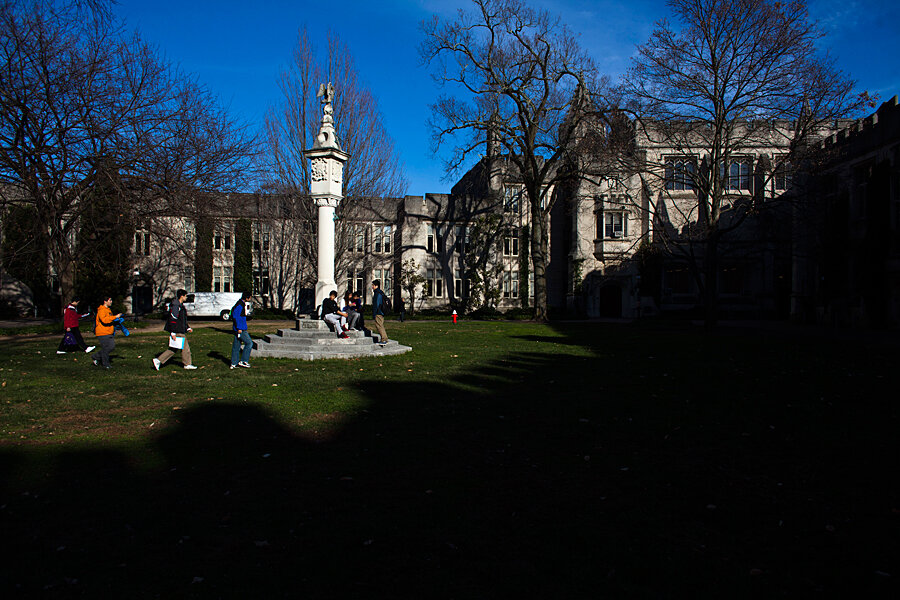US News college rankings: Princeton holds on to top spot. Is it really No. 1?
Loading...
Princeton fans can breathe a sigh of relief: For the second year in a row, that school came out on top in the US News & World Report rankings, ahead of Harvard and Yale.
For national liberal arts colleges, Williams College in Williamstown, Mass., also held onto its No. 1 spot from last year, with Amherst and Swarthmore close behind.
In fact, as with most years, there was very little movement in the rankings, which are determined based on graduation and retention rates, assessment of excellence (largely determined by peer surveys), faculty resources, selectivity, financial resources, how well graduation rates match up with what is predicted, and alumni giving.
The top 10 national universities were the same as last year, with just a few shifting place, with the small exception of Dartmouth College, which dropped from a tie for 10th place to 11th place in this year’s rankings.
College rankings have become a popular game, with numerous other publications issuing their own – some of them based more on concrete outcomes or affordability than the US News ones. Even the federal government plans to get into the college ratings business (though they emphasize the distinction between “ratings” and “rankings"), based largely on access and affordability. But US News, which has been publishing its rankings for 30 years now, remains both the most well known and the most controversial.
In recent years, as the problems of rising college costs and student debt have risen to the forefront, the US News rankings are frequently cited as part of the problem.
At best, say critics, they’re of little use, giving students and their families almost no real information about value or outcomes, and just reinforcing previously cemented reputations. At worst, they say, they contribute to the spiraling costs of college, encouraging schools to spend money in unnecessary and inefficient ways on fancy buildings and amenities, in hopes of raising their prestige and inching up in the rankings.
They can also encourage schools to increase the average SAT scores of their student body by offering hefty “merit aid” packages to certain students, regardless of students’ financial need.
In a New Yorker essay on the topic, “What College Rankings Really Tell Us,” Malcolm Gladwell explored how arbitrary and self-reinforcing the rankings become, given the nearly impossible task of rating totally different institutions with a single score.
“A single score allows us to judge between entities (like Yeshiva and Penn State) that otherwise would be impossible to compare. At no point, however, do the college guides acknowledge the extraordinary difficulty of the task they have set themselves,” Gladwell wrote. “The Penn State campus at University Park is a complex institution with dozens of schools and departments, four thousand faculty members, and forty-five thousand students. How on earth does anyone propose to assign a number to something like that?”
But, despite all the criticism they generate, parsing the US News rankings has become a rite of passage for many in the higher-ed community, and colleges are eager for even small movement – so long as it’s in the right direction.
This year, Northeastern University and University of California in Irvine made the biggest jumps in the national university category, both rising seven places, to a five-way tie at No. 42. Pennsylvania State University in University Park, meanwhile, fell seven places.
Some of the more interesting rankings are in the lesser-known lists that US News publishes. University of Maryland in Baltimore County, Arizona State University in Tempe, and the University of Central Florida topped the list of “up-and-comers,” those universities most often cited by college administrators asked to nominate schools that have made the most promising and innovative changes. And Rutgers, Andrews University, and Stanford offer the most ethnic diversity of national universities.
A list of “A-plus schools for B students” highlights less-selective schools. And US News has created its own list of “best value” schools – a trend among many other college-ranking publications – though the results don’t look all that different from the main lists. Harvard, Princeton, and Yale are still the top three national universities, though the University of Chicago and Duke University drop out of the top 10 on the “value” list.
For the first time this year, US News is also publishing data on the school profile pages about each school’s three-year federal loan default rate – a measure of graduates’ ability to repay their loans – and their safety statistics.








